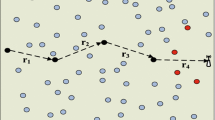Abstract
This paper proposes a new relaying selection scheme that enhances the energy efficiency and packet delivery ratio for dual-hop wireless cooperative networks by using multiple forwarding protocols. In wireless networks, a relaying technique achieves spatial diversity gain to reduce errors and increase bit rates of systems; hence, it has become an attractive approach for multi-hop forwarding networks. In this study, relay nodes are able to forward messages from a source node by either the amplify-and-forward or the decode-and-forward protocol. By estimating the channel gain and residual energy of the relay nodes, a relaying selection algorithm is proposed in order to determine the best relay node for cooperation with the source node. As a result, relay nodes can maintain the balance of energy dissipation, extending network lifetime and reducing the packet error rate. Numerical evaluations show that the proposed scheme achieves energy efficiency and reliability for two-hop wireless sensor networks (WSNs).








Similar content being viewed by others
References
Bao, X., & Li, J. (2007). Efficient message relaying for wireless user cooperation: Decode-amplify-forward (DAF) and hybrid DAF and coded-cooperation. IEEE Transactions on Wireless Communications, 6(11), 3975–3984. doi:10.1109/TWC.2007.06117.
Can, B., Yomo, H., & de Carvalho, E. (2006). Hybrid forwarding scheme for cooperative relaying in OFDM based networks. IEEE International Conference on Communications, 10, 4520–4525. doi:10.1109/ICC.2006.255351.
Engel, F., Abrao, T., & Hanzo, L. (2013). Relay selection methods for maximizing the lifetime of wireless sensor networks. In IEEE wireless communications and networking conference (WCNC) (pp. 2339–2344). doi:10.1109/WCNC.2013.6554926.
Hoa, T. D., & Kim, D. S. (2013). Data forwarding algorithm over lossy links in wireless sensor networks. IEICE Communications Express, 2(10), 453–458.
Huang, W. J., Hong, Y. W., & Kuo, C. C. (2008). Lifetime maximization for amplify-and-forward cooperative networks. IEEE Transactions on Wireless Communications, 7(5), 1800–1805. doi:10.1109/TWC.2008.061075.
Hui, H., Zhu, S., & Lv, G. (2010). Relay selection for lifetime extension in amplify-and-forward cooperative networks. In IEEE international conference on communications (ICC) (pp. 1–5). doi:10.1109/ICC.2010.5502502.
Hunter, T., & Nosratinia, A. (2006). Diversity through coded cooperation. IEEE Transactions on Wireless Communications, 5(2), 283–289. doi:10.1109/TWC.2006.1611050.
Krikidis, I. (2010). Relay selection for two-way relay channels with MABC DF: A diversity perspective. IEEE Transactions on Vehicular Technology, 59(9), 4620–4628.
Laneman, J., Tse, D., & Wornell, G. W. (2004). Cooperative diversity in wireless networks: Efficient protocols and outage behavior. IEEE Transactions on Information Theory, 50(12), 3062–3080. doi:10.1109/TIT.2004.838089.
Liu, J., Lu, K., Cai, X., & Murthi, M. (2009). Regenerative cooperative diversity with path selection and equal power consumption in wireless networks. IEEE Transactions on Wireless Communications, 8(8), 3926–3932. doi:10.1109/TWC.2009.081030.
Liu, T., Song, L., Li, Y., Huo, Q., & Jiao, B. (2012). Performance analysis of hybrid relay selection in cooperative wireless ystems. IEEE Transactions on Communications, 60(3), 779–788. doi:10.1109/TCOMM.2012.011312.110015.
Mousavifar, S. A., & Leung, C. (2013). Lifetime analysis of a two-hop amplify-and-forward opportunistic wireless relay network. IEEE Transactions on Wireless Communications, 12(3), 1186–1195. doi:10.1109/TWC.2012.12.120364.
Pham, T. L., & Kim, D. S. (2013). Lossy link-aware routing algorithm for ISA100.11a wireless networks. In IEEE international conference on industrial informatics (INDIN) (pp. 624–629).
Tabataba, F., Sadeghi, P., & Pakravan, M. R. (2011). Outage probability and power allocation of amplify and forward relaying with channel estimation errors. IEEE Transactions on Wireless Communications, 10(1), 124–134. doi:10.1109/TWC.2010.102810.091729.
Tan, D. D., Dinh, N. Q., & Kim, D. S. (2013). GRATA: Gradient-based traffic-aware routing for wireless sensor networks. IET Wireless Sensor Systems, 3(2), 104–111.
Tan, D. D., & Kim, D. S. (2013). Dynamic traffic-aware routing algorithm for multi-sink wireless sensor networks. Wireless Networks. doi:10.1007/s11276-013-0672-z.
YANG, W., hua LI, L., lu SUN, W., & WANG, Y. (2010). Energy-efficient relay selection and optimal relay location in cooperative cellular networks with asymmetric traffic. The Journal of China Universities of Posts and Telecommunications, 17(6), 80–88.
Yu, H., Li, Y., Zhong, X., Wang, L., & Wang, J. (2013). The analysis of the energy efficiency for the decode-and-forward two-way relay networks. In IEEE wireless communications and networking conference (WCNC) (pp. 2823–2827). doi:10.1109/WCNC.2013.6555008.
Zarifi, K., Abuthinien, M., Ghrayeb, A., & Affes, S. (2009). Relay selection schemes for uniformly distributed wireless sensor networks. In IEEE wireless communications and networking conference (WCNC) (pp. 1–6).
Zheng, L., & Tse, D. (2003). Diversity and multiplexing: A fundamental tradeoff in multiple-antenna channels. IEEE Transactions on Information Theory, 49(5), 1073–1096. doi:10.1109/TIT.2003.810646.
Acknowledgments
This research was financially supported by National Research Foundation of Korea (NRF) through the Human Resource Training Project for Regional Innovation 2015 (NO. NRF-2015H1C1A1035971) and the MSIP (Ministry of Science, ICT and Future Planning), Korea, under the “Creative ICT Convergence Human Resource Development Program” (NO. IITP-2015-H8601-15-1011) support program supervised by the IITP (Institute for Information and communications Technology Promotion).
Author information
Authors and Affiliations
Corresponding author
Rights and permissions
About this article
Cite this article
Pham, TL., Kim, DS. Efficient Forwarding Protocol for Dual-Hop Relaying Wireless Networks. Wireless Pers Commun 89, 165–180 (2016). https://doi.org/10.1007/s11277-016-3258-0
Published:
Issue Date:
DOI: https://doi.org/10.1007/s11277-016-3258-0




